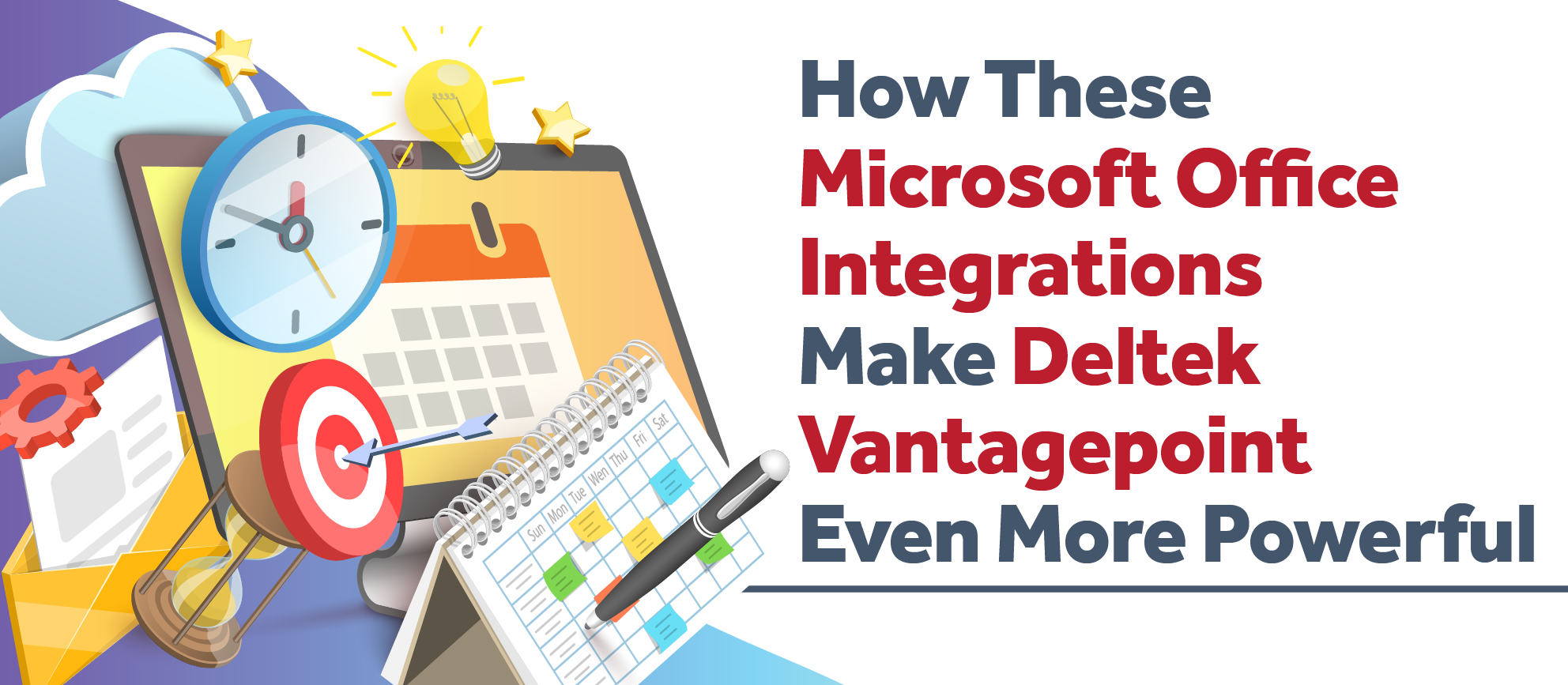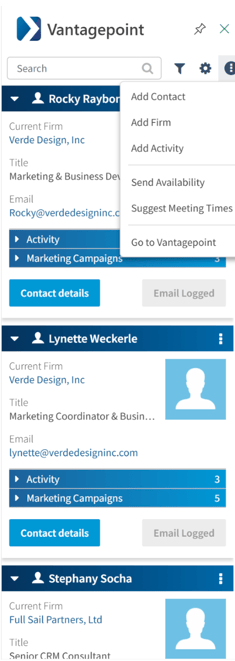How These Microsoft Office Integrations Make Deltek Vantagepoint Even More Powerful

As someone who has worked with Deltek Vantagepoint for years, I can confidently say that it’s a powerhouse for project-based firms. But what really takes its functionality to the next level? It's seamless integration with Microsoft Office, particularly Outlook and Teams. These integrations don’t just make your life easier—they make your work more efficient, more connected, and ultimately, more valuable.
If you’re not already using the Vantagepoint Connect Add-in for Outlook or leveraging the Teams integration within Vantagepoint, let me introduce you to the game-changers that will revolutionize how you manage projects, communications, and collaboration.
Vantagepoint Connect: Outlook Add-in
Turning Your Inbox into an Extension of Vantagepoint
We all live in our inboxes, so why not make Outlook work smarter? With the Vantagepoint Connect Add-in for Outlook, your CRM and project management tools are just a click away—right inside your email.
Key Features That Save You Time and Effort:

- Easily Add Contacts and Firms
Got an email from a new potential client? Instead of manually entering their information into Vantagepoint, just open the Vantagepoint Connect pane inside Outlook and instantly create a new Contact or Firm record. - Log Emails as Activities
Ever had an important client conversation get lost in the email abyss? With just one click, you can log emails directly into Vantagepoint as an Activity, keeping a clear record of communications tied to the right firm, project, or marketing campaign. - Schedule Meetings Without the Back-and-Forth
The built-in Scheduling Assistant lets you send availability links, propose meeting times, and even create Teams meetings—right from Outlook. No more endless email chains trying to find a time that works. - Search Your Vantagepoint Database from Outlook
Need to check if someone is already in your system? The search bar inside the Vantagepoint Connect pane lets you pull up records for Contacts, Firms, Projects, and Activities without ever leaving your email.
Why This Matters:
Instead of bouncing between applications, you can perform essential CRM tasks directly in Outlook. The result? A faster, more connected workflow that ensures your data stays up to date with minimal effort.
Microsoft Teams + Vantagepoint: Instant Collaboration, Right Where You Need It
Bridging the Gap Between Project Data and Real-Time Communication
We all know that great projects are built on effective communication. With Microsoft Teams integration inside Vantagepoint, staying connected with your team has never been easier. Instead of switching between platforms or hunting for contact info, you can start a Teams chat directly from within Vantagepoint—right where you are already working.
How It Works:
- See Who Is in the Same Record as You
If other users are currently in the same record in Vantagepoint—whether it is a project, contact, or another hub—you will see their presence via a small chat bubble next to their name (see screenshot below). - Instantly Start a Teams Chat
Need to ask a quick question or clarify project details? Simply hover over the chat bubble and initiate a one-on-one Microsoft Teams chat directly from Vantagepoint. No need to search for their name in Teams or leave your workflow. - Seamless Setup
If your firm has enabled the Microsoft Teams Chat option in Settings » General » Communications, you can immediately start chatting with team members without leaving Vantagepoint.
Why This Matters:
When working on projects, timing is everything. Instead of sending an email and waiting hours for a reply, you can now ping a teammate in Teams and get an answer instantly. This eliminates communication delays, reduces email clutter, and keeps teams aligned in real-time.
With the Teams Chat integration, Vantagepoint is no longer just your project management system—it’s your real-time collaboration hub.
Why These Integrations Are a Must for Any Vantagepoint User
Whether you are a BD professional, a project manager, or a marketing leader, these integrations provide three major benefits:
- Time Savings: No more duplicate data entry or switching between multiple applications.
- Better Collaboration: Keep teams aligned with real-time access to shared information.
- Stronger Data Integrity: Ensure that all interactions and project updates are automatically captured inside Vantagepoint.
By integrating the tools, you already use every day—Outlook and Teams—Deltek Vantagepoint becomes even more powerful. It’s about working smarter, not harder.
Take Your Vantagepoint Experience to the Next Level
With Microsoft Outlook and Teams integrations, Deltek Vantagepoint isn’t just a project management system—it’s a powerhouse for seamless collaboration, streamlined workflows, and smarter communication. If you’re not taking full advantage of these tools yet, now is the perfect time to get started!
Want to see the Outlook integration in action? Watch my mini-demo, to see how Vantagepoint Connect can help you work smarter—right inside Outlook. Click below to watch today!












 If you’ve been using Deltek Vantagepoint but haven’t kept up with the latest versions, you might be missing out on some game-changing features. Versions 7.0, 7.1, and 7.2 are packed with updates that make navigating, managing, and automating your work easier than ever. From smarter navigation to advanced AI tools, these updates are designed to save you time and streamline your processes. Let’s dive into the highlights to see what you might have overlooked!
If you’ve been using Deltek Vantagepoint but haven’t kept up with the latest versions, you might be missing out on some game-changing features. Versions 7.0, 7.1, and 7.2 are packed with updates that make navigating, managing, and automating your work easier than ever. From smarter navigation to advanced AI tools, these updates are designed to save you time and streamline your processes. Let’s dive into the highlights to see what you might have overlooked!


















